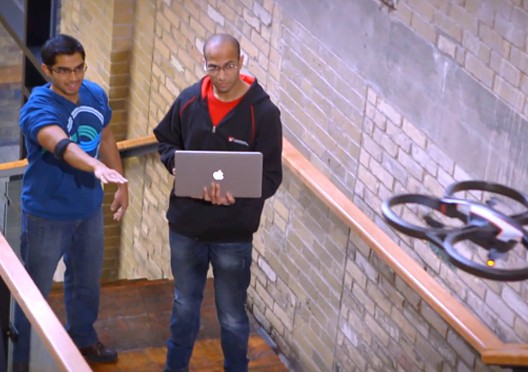

We’ve seen few tech developments recently that have drawn as much breathless excitement as Thalmic Labs’ MYO armband. News outlets from around the world spent February and March salivating over the Canadian-made device’s cool factor, while the video associated with the announcement racked up over two-million views.
The technology around MYO seems so filmic and futuristic that many reviewers drew comparison to science fiction. “Star Wars” meets “Minority Report” gushed a typical notice.
One of the things that keeps us hanging on with regard to the MYO armband is the “How did they do it?” factor. So Thalmic Labs has put together a “behind the scenes” video which gives a small peek inside the process. With most tech talk these days revolving around “the cloud” and social media, you could be forgiven for believing that an economy is being built around things that perhaps don’t even really exist. So there is something reassuringly old-school watching this video from Thalmic Labs, seeing Stephen Lake sitting at a table with soldering irons, circuit boards and oscilloscopes at their research and development facility in Waterloo.
“We’ve actually got complete in-house capabilities here. We’re able to build and prototype any device we want, which really accelerates the process and really allows us to evolve the product at a faster rate,” says Scott Greenberg, who handles developer relations.
After unveiling the MYO armband in February, Thalmic Labs booked more than $4-million through 25,000 device pre-sales, mainly as the consequences of the nearly “Jedi”-like levels of geeky excitement. “Our original goal was to sell 7,000 units by the end of March, and instead we sold 25,000 within the first month of its launch. Consumers have really embraced the new technology, and we’re working hard to have them in the hands of our first customers later this year,” said Lake back in March.
Lake and his colleague Matthew Bailey studied mechatronics engineering at the University of Waterloo, a field that combines electronics, mechanical design, software engineering and systems integration. MYO was the culmination of their studies.
Greenberg has been in charge of fielding ideas from developers eager to propose possible applications for the new device. “I’ve got to say, I’m amazed at the ideas I’m getting, and I’m really excited,” he said.
In the next few months, says Greenberg, Thalmic will be rolling out an early version of the software associated with the armband, allowing access to developers to study the nuts and bolts of MYO’s inner workings, which in turn ought to spur further innovation as the possibilities for the device become clearer. Both Windows and Mac operating systems will be supported, with APIs available for iOS and Android.
While the science fiction possibilities for wearable technology and ubiquitous computing have been hinted at in past decades, it’s only been in the last year that actual devices have been available to buy and use. With Thalmic Labs’ open attitude to collaborating with outside developers, the possibilities for the next decade seem limitless.
Leave a Reply
You must be logged in to post a comment.



 Share
Share Tweet
Tweet Share
Share




Comment